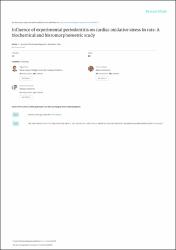Influence of experimental periodontitis on cardiac oxidative stress in rats: a biochemical and histomorphometric study

View/
Access
info:eu-repo/semantics/openAccessDate
2017Author
Köse, OğuzArabacı, Taner
Yemenoğlu, Hatice
Özkanlar, Seçkin
Kurt, Nezahat
Gümüşsoy, İsmail
Kara, Adem
Metadata
Show full item recordCitation
Köse, O., Arabacı, T., Yemenoglu, H., Ozkanlar, S., Kurt, N., Gumussoy, I., Gedikli, S., & Kara, A. (2017). Influence of experimental periodontitis on cardiac oxidative stress in rats: a biochemical and histomorphometric study. Journal of periodontal research, 52(3), 603–608. https://doi.org/10.1111/jre.12428Abstract
Background and ObjectiveThe role of oxidative stress in the process of cardiac remodeling, hypertrophy and heart failure is a current topic. the purpose of this experimental study was to investigate the influences of periodontitis on levels of cardiac oxidative stress. Material and MethodsTwenty rats were separated into two groups: control and experimental periodontitis (EP). Periodontitis was induced by placing a 3.0 silk suture in the cervix of the left and right mandibular first molar teeth for 5 wk. At the end of the experiment, the animals were killed and blood samples and mandibular and ventricular cardiac tissue samples were collected. Levels of alveolar bone loss were determined using measurements performed on histological slices and radiographies. Left ventricular tissue 8-hydroxy-2-deoxyguanosine, malonylaldehyde, glutathione peroxidase, total oxidant status, total antioxidant status (TAS) levels and serum paraoxonase-1 activity were evaluated biochemically. ResultsMeasurements performed on the histological slices and radiographies demonstrated that applying the ligature caused obvious alveolar bone loss. Oxidative damage markers (malonylaldehyde, 8-hydroxy-2-deoxyguanosine, oxidative stress index: total oxidant status/TAS) were significantly higher, and antioxidant markers (glutathione peroxidase, TAS) were statistically insignificantly higher, in the hearts of rats with EP when compared to the controls. in addition, reduced serum paraoxonase-1 activity was also detected in the EP group. ConclusionThe pronounced increase in cardiac oxidative stress caused by periodontitis was due to an excessive increase in the production of reactive oxygen species, rather than due to decreased antioxidant capacity. the results indicate that periodontitis-related cardiac oxidative stress might be one of the mechanisms that contribute to the pathological process that leads to heart failure.

















